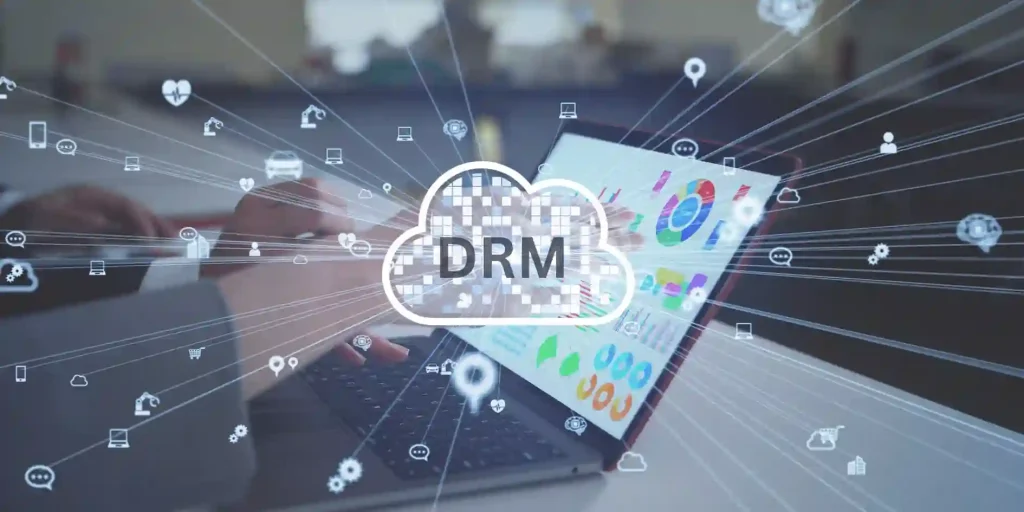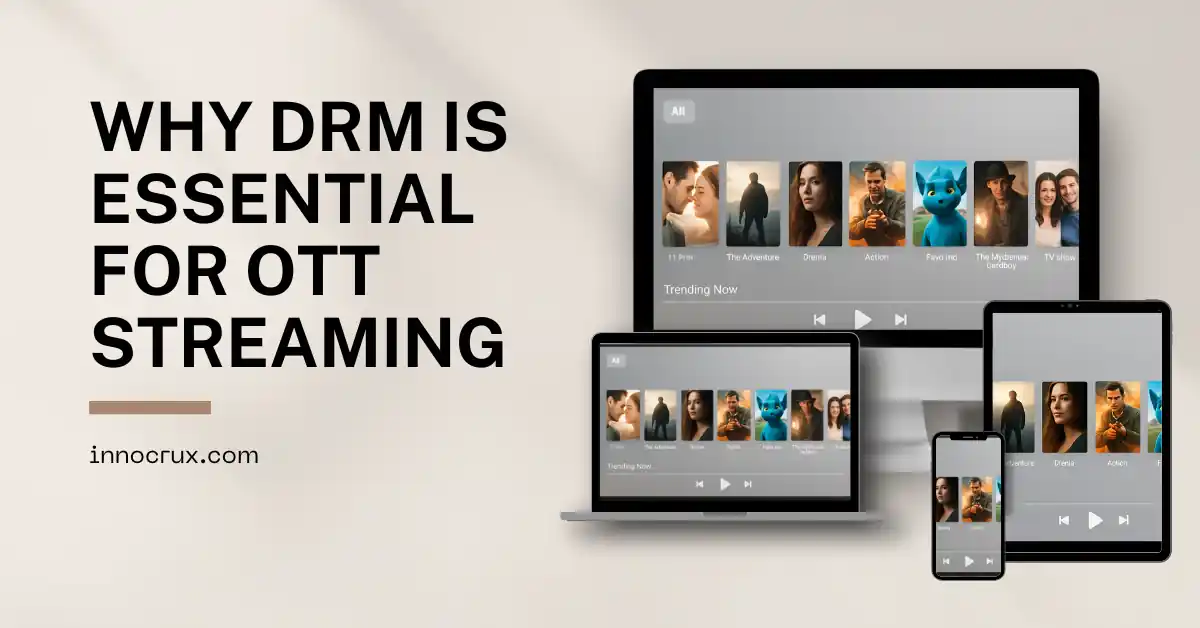Introduction: The Growing Risk to Premium OTT Content
As digital video becomes the cornerstone of modern entertainment, OTT platform providers face an evolving security crisis. The rapid shift to online viewing has exposed premium content to global piracy threats, including unauthorized screen capture, content leakage, account sharing, and illegal streaming networks. The stakes are especially high for platforms offering exclusive live streaming solution, subscription video on demand (SVOD), and premium pay-per-view content.
With increasing viewer demand for high-quality, cross-device content, OTT solutions must do more than deliver—they must protect. This is why robust DRM integration is no longer a feature, but a foundational requirement for any white-label OTT platform. Without it, platforms risk losing monetization opportunities, breaking compliance with licensing partners, and damaging viewer trust.
Premium content isn’t just a product—it’s a high-value asset. And without DRM, that asset is up for grabs.
What Is DRM and Why It Matters in Streaming
Digital Rights Management (DRM) is a vital content protection technology that ensures only authorized users, devices, and regions can access your video streams. DRM encrypts video content during upload and delivery, making it impossible for unauthorized viewers to download or redistribute protected files.
In OTT streaming solutions, DRM is indispensable to enforce viewing restrictions, prevent piracy, and protect your intellectual property. Whether you’re offering live OTT broadcasting, video-on-demand (VOD) libraries, or IPTV services, DRM helps you retain full control over how, where, and by whom your content is consumed.
It also enables time-bound access, region-specific distribution, and multiple playback policies based on monetization models. With DRM, you don’t just protect content—you preserve licensing value and secure user trust.
Top DRM Technologies: Widevine, FairPlay, and PlayReady
To ensure maximum reach and security, most enterprise-grade OTT platforms implement a multi-DRM strategy, which includes:
- Google Widevine: Used across Android, Chrome, Chromecast, and many smart TV ecosystems.
- Apple FairPlay: Required for secure streaming on iOS, macOS, and Safari browsers.
- Microsoft PlayReady: Supports Windows, Edge, Xbox, and many Smart TVs and set-top boxes.
Each DRM system works with different operating environments, and together they enable secure playback across all major devices. Multi-DRM solutions automatically deliver the appropriate license and encryption key based on the user’s device and browser—ensuring frictionless playback and maximum protection.
An ideal white-label OTT solution should come with seamless multi-DRM integration that ensures viewers don’t experience login friction or device restrictions, while still keeping content shielded behind robust encryption layers.
Piracy in 2025: How Premium OTT Content Is Targeted
The piracy ecosystem in 2025 is no longer limited to torrent platforms. It has matured into a commercial, global industry, operating at the same scale—and sometimes speed—as legitimate OTT services. Key threats include:
- Stream recorders mimicking native screen capture tools
- Subscription-sharing rings exploiting stolen login credentials
- Illegal OTT clones replicating premium OTT video solutions
- Organized piracy operations distributing real-time VOD content
For platforms offering live streaming solutions, IPTV OTT solutions, or blockbuster video on demand platforms, this presents a major challenge. Piracy directly reduces profitability, voids licensing contracts, and discourages advertisers who demand secure environments.
In many regions, pirated content is reuploaded to mirror OTT apps, Telegram groups, or social media platforms just minutes after release. This makes protection essential not just for major studios but also for businesses trying to build live video streaming web applications, launch white-label VOD platforms, or deliver church streaming services.
Only platforms that implement end-to-end OTT solutions with studio-approved DRM technologies and monitoring systems like watermarking can counteract this. A custom OTT solution development effort is incomplete without a secure foundation that prevents digital theft at every touchpoint.

DRM’s Role in Licensing and Studio Compliance
In the world of OTT in 2025, DRM isn’t optional—it’s a studio compliance standard. No major distributor will license premium content without strict DRM policies in place. Whether you’re building a white-label OTT solution, a live streaming app, or a VOD platform, DRM is your entry ticket to top-tier content partnerships.
Studios require DRM to:
- Enforce geo-restrictions based on licensing rights
- Control playback windows during exclusive release periods
- Ensure content remains secured across SVOD, TVOD, and AVOD models
- Limit usage to approved user accounts and device types
For any OTT solution provider in India or globally, implementing DRM boosts your credibility and ensures regulatory compliance. When you build an OTT platform from scratch, DRM also reduces the risk of copyright infringement fines and legal consequences tied to unsecured content distribution.
Multi-Device, Multi-DRM: Delivering Secure Playback Everywhere
Today’s streaming audience uses smartphones, tablets, desktops, connected TVs, and even game consoles. To serve this diverse ecosystem, every OTT streaming solution must offer multi-device compatibility with multi-DRM support.
Without multi-DRM integration, you risk:
- Playback failures on browsers like Safari or Chrome
- Security gaps on iOS or Android apps
- License violations when users bypass content restrictions
Whether you’re working to build a live streaming app, launch a video on demand platform, or expand your OTT TV solution, using Widevine, FairPlay, and PlayReady together ensures that content plays securely on every screen.
A truly modern end-to-end OTT solution protects user experience and content simultaneously. For OTT platform providers, multi-DRM is no longer a premium feature—it’s a foundational requirement.
How DRM Supports SVOD, TVOD, and Live Monetization Models
As the streaming landscape diversifies, platforms now support multiple monetization models—and each one depends on DRM to remain profitable.
SVOD (Subscription Video on Demand)
In SVOD, users pay for ongoing access. DRM ensures only valid, paying subscribers can stream content. It blocks shared passwords, expired logins, and unauthorized downloads—core issues in today’s OTT video solution landscape.
TVOD (Transactional Video on Demand)
TVOD services rely on pay-per-view or one-time purchases. Without DRM, rented content could be recorded, shared, or sold illegally. DRM locks content to specific users and devices, ensuring a secure transaction. This is crucial when you build VOD platforms that offer premium episodic content or limited-time rentals.
Live Streaming
Live events like sports, concerts, or religious broadcasts face real-time threats. DRM encrypts and protects streams from restreaming or hijacking. When paired with access control, it ensures only authorized users watch your event on approved devices.
Whether you’re launching the best live streaming solution for churches, developing a fitness VOD platform, or integrating multiple revenue models into a custom OTT solution, DRM ensures that every viewer is accounted for and every stream is monetized.
Combining DRM with Watermarking for Maximum Protection
For ultra-premium content—sports finals, movie premieres, government broadcasts—DRM must work hand-in-hand with forensic watermarking to provide bulletproof protection.
Watermarking embeds imperceptible, unique user IDs directly into the video stream. Even if someone screen-records DRM-protected content, the watermark lets you trace the leak back to the user or device, acting as a powerful deterrent.
This dual-layer security is vital for:
- High-stakes OTT releases or live events
- Subscription packages with exclusive VOD titles
- Corporate or government content that must not leak
DRM prevents unauthorized access, while watermarking deters and traces distribution abuse. Together, they form the gold standard for OTT content protection, giving you legal and operational confidence.
Platforms like Innocrux implement both out-of-the-box, giving you total control over playback, redistribution, and accountability.
Why DRM Is Critical for Global OTT Expansion
Going global with your OTT streaming service isn’t just about adding languages and currencies—it’s about meeting international content protection standards.
Different regions impose different laws:
- EU GDPR & ePrivacy demand secure personal data and consent
- India’s digital laws prioritize content traceability and compliance
- Hollywood studios require DRM for content licensing in North America
Multi-DRM support, coupled with regional geo-fencing, legal compliance, and secure payment workflows, helps OTT platforms:
- Secure premium licensing deals across territories
- Reduce risk of non-compliance and platform bans
- Build user trust in regions sensitive to data and content regulation
DRM becomes your passport to global reach. Whether you’re launching in the Middle East, Africa, India, or North America, DRM makes your OTT app globally acceptable and locally compliant.
Innocrux’s DRM-Enabled OTT Platform: Future-Proof and Studio-Ready
Innocrux, a trusted name in OTT platform development, offers a ready-to-deploy DRM-powered white-label OTT solution that combines enterprise security, performance, and flexibility.
Built for brands, broadcasters, religious networks, sports federations, and educators, the Innocrux platform includes:
- Full DRM coverage: Widevine, FairPlay, PlayReady
- Secure live and VOD delivery with multi-CDN and edge streaming
- Support for AVOD, SVOD, TVOD, and hybrid monetization
- Watermarking, token-based access control, and IP/domain restrictions
- Integrated viewer analytics, content tagging, and payment gateways
You get everything needed to launch a studio-compliant OTT video solution, while enjoying full control of UI/UX, domain branding, monetization, and audience engagement.
With Innocrux, you’re not just buying DRM—you’re investing in a future-proof OTT ecosystem tailored to scale and monetize securely in 2025 and beyond.
Conclusion: Why DRM Is No Longer Optional
DRM is no longer a technical add-on—it’s a non-negotiable foundation for any serious OTT streaming solution. As content piracy evolves and monetization models diversify, only DRM-enabled platforms can ensure studio compliance, global scalability, and user trust. Whether you’re exploring how to build OTT apps, a custom VOD solution, or a live video streaming platform, secure your future with robust DRM at the core.
It’s not just about protecting content—it’s about protecting your brand, your partnerships, and your revenue streams. With growing pressure from content licensors and rising piracy sophistication, DRM plays a key role in maintaining platform credibility.
Platforms that invest early in DRM build stronger relationships with premium content providers, attract bigger ad deals, and gain faster entry into new markets. To thrive in the competitive OTT landscape of 2025, content protection must evolve in parallel with your platform.
Choose a DRM-enabled, white-label OTT solution like Innocrux—and stream with confidence, control, and future-ready security.








No comments yet